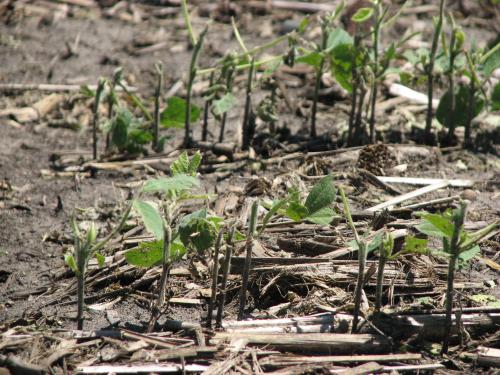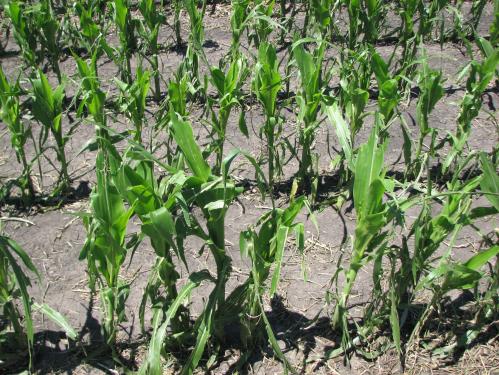June 11, 2018

Source: Iowa State University
Widespread hail occurred in Iowa on 6 June 2018, causing damage to many acres of corn and soybean plants. At this time, most of the corn is in the V6 to V8 growth stages, while soybeans are at the V1 to V3 growth stages. Some areas of the state also received hail injury earlier this season. Questions have been raised regarding the benefit of a fungicide application to hail-damaged crops in these early to mid vegetative stages.

Tattered leaf tissue and broken leaf midribs on vegetative stage corn resulting from hail. Photo by Mark Licht.
There are a few reasons given for fungicide application to crops after a hail event. It is argued that crops may be more susceptible to fungal pathogens resulting from increased stress due to the hail injury, or that wounding may allow pathogens to invade plant tissue. Another reason fungicides are considered post hail is that physiological benefits gained from a fungicide application are thought to help sustain or increase yield of damaged crops. It is important to note that claims by the chemical industry do not state fungicide applications recover yield potential lost due to hail damage. But some claims do suggest fungicide application to hail-damaged crops will protect the remaining green tissue and allow plants to maximize yield after sustaining damage.
In order to help answer the question of whether or not fungicide application after a hail event during vegetative crop stages is beneficial, field research trials were undertaken by Iowa State University researchers. During 2015 and 2016, trials at research farms in Kanawha, Iowa, and Ames, Iowa were performed using a hail simulation machine and subsequent fungicide application.
In corn, hail was simulated at approximately V5 and V9 and fungicide (pyraclostrobin + metconazole) was applied 1 to 2 weeks later as a “post hail response” or at R1. A treatment that had both the post hail response fungicide and R1 fungicide application was included.
In soybean, hail was simulated at approximately V5, and fungicide (fluxapyroxad + pyraclostrobin) was applied approximately 7-10 days later as a post hail response and also at R3. A treatment including both the post hail response and R3 application was included as well.
Although analysis is ongoing, a preliminary examination of results may indicate the following:
Corn. As expected, plots with hail injury yielded less than non-injured plots. However, fungicide application as a post hail response or at any other timing did not provide significant (P=0.1) yield-increasing plant health benefits for corn after V5 and V9 hail when compared to plots that did not receive fungicide.
Soybean. As expected, soybean plots with hail injury yielded less than non-injured plots. The soybean yield data is a bit more complex than the corn, but what it does tell us is that a single, post hail response fungicide application does not statistically (P=0.1) increase yield after V5 hail when compared to plots that did not receive fungicide.
These data are similar to those we previously reported for fungicide applications after a hail event during early grain fill. In general, a fungicide application may not provide yield-increasing benefits after an early-season hail event when risk of foliar diseases is low. Furthermore, it is important to consider how low grain prices increase the number of bushels needed to recover the cost of fungicide application.
If you do plan on making a fungicide application after early-season hail, it may be advantageous to leave an untreated strip in the field to determine if the application was beneficial come harvest – not only in terms of yield, but also economically.
The following resources are available from ISU Extension and Outreach Publications as free downloads:
Hail on Corn in Iowa (IPM 0078) at https://store.extension.iastate.edu/product/14776
Hail on Soybean in Iowa (IPM 0079) at https://store.extension.iastate.edu/product/14792
Originally posted by Iowa State University Extension.
You May Also Like




